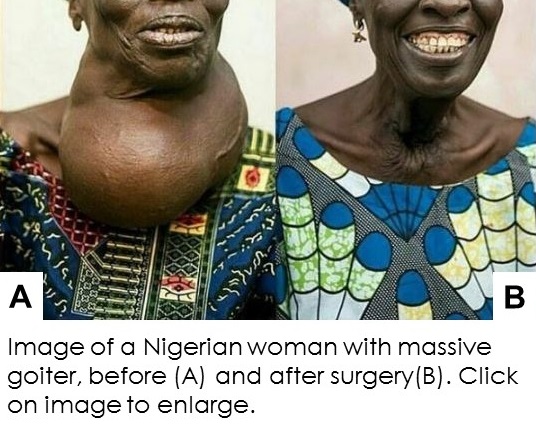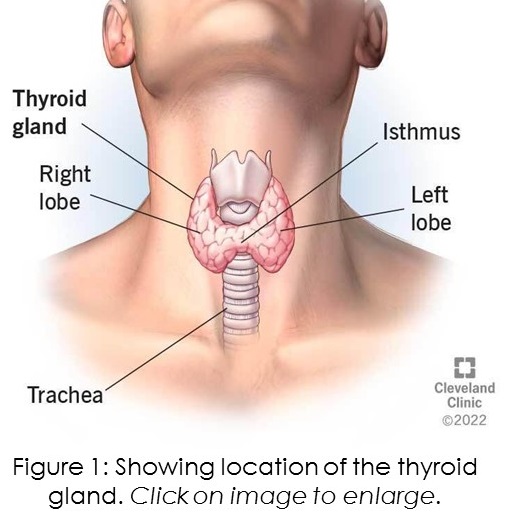
A goiter is an abnormal swelling of the thyroid gland in front of the neck which is visible while swallowing. The enlarged mass can vary in size and moves from top to bottom.
A goiter can develop due to certain conditions like hyperthyroidism (when the thyroid gland produces too much of its hormone) and hypothyroidism (when the thyroid gland produces fewer amounts of its hormone).
 Location of the thyroid gland and how it works
Location of the thyroid gland and how it worksThe thyroid gland is a small butterfly-shaped organ located in front of the windpipe (trachea) and at the base of the neck below Adam's apple. It is larger in males than in females.
It weighs approximately 10 - 25g and has two lobes (right and left) joined by an isthmus (a bridging part). It secretes two hormones that are called: Triiodothyronine(T3) and Thyroxine (T4). These hormones are responsible for metabolic processes in the body.
The pituitary gland and hypothalamus in your brain regulate the production of T3 and T4.
When T3 and T4 levels are low, the hypothalamus produces thyrotropin-releasing hormone (TRH) which signals the pituitary gland to produce thyroid-stimulating hormone (TSH). The TSH signals the thyroid gland to produce more T3 and T4. When T3 and T4 levels are high, the pituitary gland stops producing TSH.
There are three types of goiter:
A UNICEF survey of goiter in Nigerian school children, reported a goiter rate of 20% and over 20 million Nigerians were estimated to have iodine deficiency.
Another study reported an estimated 40.2% goiter rate among primary school children in Ibadan.
The variation in rates are most likely due to differences in study methodologies.
The economic impact of goiter in Nigeria is significant, particularly in areas where iodine deficiency is common. This disease can lead to reduced productivity and increased absence from work due to it's symptoms such as swelling, difficulty breathing and difficulty swallowing.
In cases where surgery might be needed, the money may not be easily accessible, especially in low-income areas.
To deal with the economic impact of goiter in Nigeria, it is important to educate the public about goiter and carry out measures that can prevent the condition from occurring in the first place, such as promoting the use of iodized salt.
Early detection and treatment of goiter can help to reduce the negative economic impact of the condition, by preventing the development of more serious health problems and reducing the need for expensive medical treatments.
The major cause of goitre worldwide is lack of iodine in the diet. This is also the commonest cause of goiter in Nigeria. Note however, that other substances (goitrogens) that interfere with iodine uptake by the third gland may also play a role in the development of endemic goiter. In Africa, goitrogens of note include thiocyanates that are often found in poorly detoxified cassava, a staple food that is commonly eaten as a source of carbohydrate.
Other causes of goiter include:
The risk factors for goitre include:
What are the symptoms of goiter?
A clear indication that you have a goiter is swelling at the base of your neck. Most people don't notice an enlarged thyroid because it grows slowly over a long time.
Other symptoms (especially at advanced stages) might include:
Doctors diagnose goiter by physical examination. They will ask about your family history, medical history and the symptoms you've experienced.
To make a more reliable diagnosis, your doctor may ask you to undergo a combination of the following tests:
You might not need treatment if your goiter isn't too large and not causing any complications. Treatment depends on the cause of the swelling.
Some treatment options include:
Prevention of goiter will be discussed at two levels: Individual and Public.
Preventing goiter at the public health level involves the following processes:
Ogbera AO, Kuku SF. Epidemiology of thyroid diseases in Africa. Indian J Endocrinol Metab. 2011 Jul;15(Suppl 2):S82-8. doi: 10.4103/2230-8210.83331.
Sanusi, RA and Ekerette, NN. Nutrition and Goiter Status of Primary School Children in Ibadan, Nigeria. African Journal of Biomedical Research. 2008. 12 (1), 37-41. (Downloads PDF document)
Jimoh AK, Ghazal MS, Adeleke AB, Adeniyi AA, Adebara IO, Babalola FO, Ajani GO, Agboola MS, Busari OA. Biochemical pattern of thyroid function test and clinical impression of thyroid disorder in a rural tertiary health institution in Nigeria. Ann Afr Med 2020; 19:89-94.
Can, AS and Rehman, A. Goiter. NIH. National Library of Medicine. 2023.
Published: April 17, 2023
© 2023. Datelinehealth Africa Inc. All rights reserved.
Permission is given to copy, use and share content without alteration or modification and subject to attribution as to source.
DATELINEHEALTH AFRICA INC., is a digital publisher for informational and educational purposes and does not offer personal medical care and advice. If you have a medical problem needing routine or emergency attention, call your doctor or local emergency services immediately, or visit the nearest emergency room or the nearest hospital. You should consult your professional healthcare provider before starting any nutrition, diet, exercise, fitness, medical or wellness program mentioned or referenced in the DatelinehealthAfrica website. Click here for more disclaimer notice.